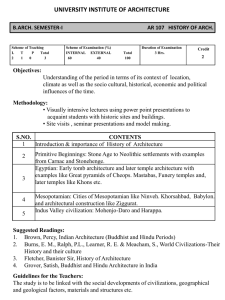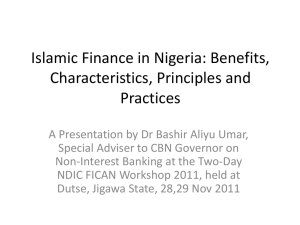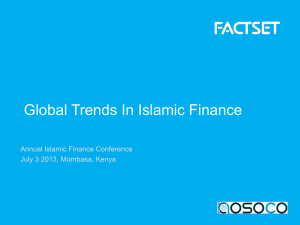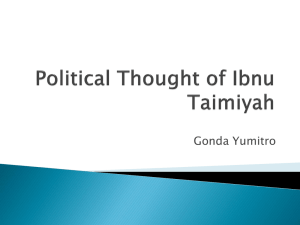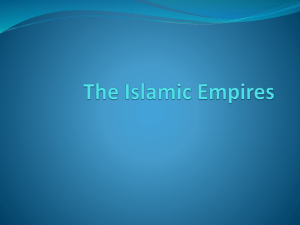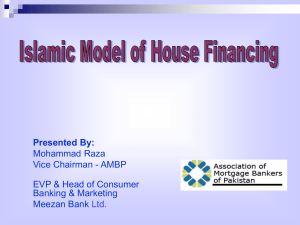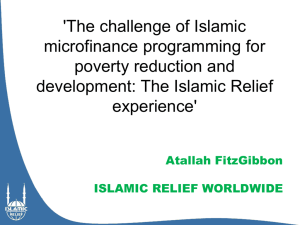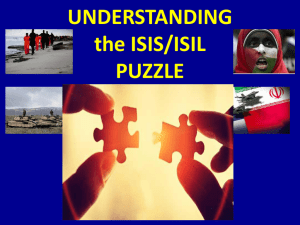Bai al Salam - nubacad.com
advertisement
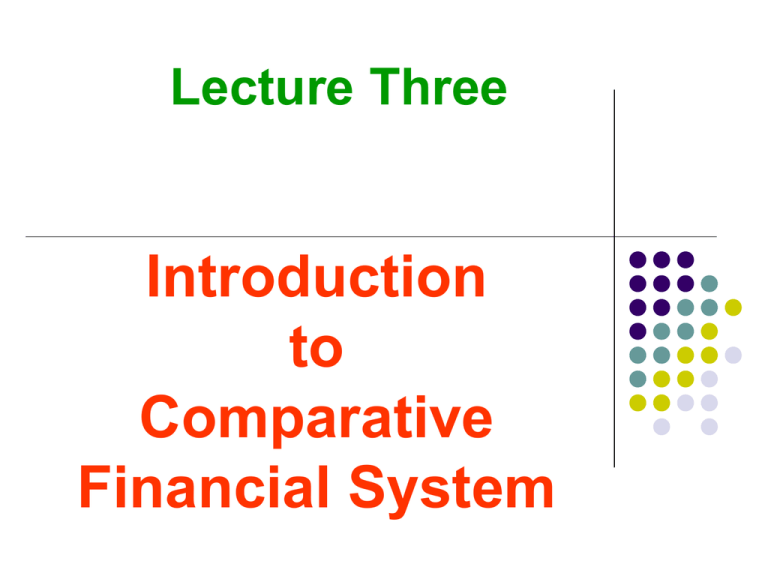
Lecture Three Introduction to Comparative Financial System Brief History of Islamic Financial System In 1963 Interest free savings bank (Mit Ghamr Saving Bank) was first introduced- invested in trade and industry in return of share of profits. During the 1970s and early 80s Egypt Nasr Social Bank, Dubai Islamic Bank, Faisal Islamic Bank of Sudan and Islamic Banks in Bahrain, Malaysia, Nigeria Indonesia, and the Philippines were established Islamic windows of the conventional banks: As of 2007 20 branches of 10 conventional banks are operating under Islamic system. Examples- HSBC Amanah fund, ANZ International Murabhah ltd, Standard Chartered Sadiq 1975 IDB was established through the Conference of Islamic Finance Ministers in 1973 – Fee and Profit Loss sharing Basis. Brief History of Islamic Financial System in Bangladesh Islamic Finance started its journey in Bangladesh in 1980s with the establishment of the Islami Bank Bangladesh Ltd (IBBL) on March 13, 1983. It was the first Islamic bank in South and Southeast Asia. Now the leading private bank in Bangladesh. At present there are 7 full fledged Islamic banks operating in Bangladesh – IBBL-1983, Al-Barakah Islami Bank Ltd 1987 (Now known as ICB Islamic Bank), Al-Arafah Islami Bank Ltd- 1995, Social Investment Bank Ltd- 1995, Shamil Bank of Bahrain- 1997, Shahjalal Islami Bank Ltd- 2001, Exim Bank Ltd- 1999 (Islamic operation from 2004), Bank Al-Falah- 2007. Definition of Islamic Finance Islamic financial system is a product of Islamic economic system which is based on the Islamic principles and philosophy (Shariah). The basic framework for an Islamic financial system is a set of rules and laws, collectively referred to as the shariah, governing social, economic, cultural, and political aspects of the Islamic society. It differs from the western worldview in the following ways: Priority in emphasis on Islam's teaching of Justice and Equity as demonstrated by the enforcement of distributive justice A spiritual framework that values human relations above material possessions A balance between individual self-interest and the common good Maximum profit and satisfaction are not the sole objectives, which in effect minimizes waste Recognition and protection of private property rights while encouraging reciprocal responsibilities. Differences Between Islamic Finance and Conventional Finance Bank Islamic Goods & Services Client Money Conventional Money Bank Client Money & Money (Interest) Differences Between Islamic Finance and Conventional Finance CFS is based on interest where as IFS is based on profit/loss or rent sharing. CFS Deals with only the financial assets such as money or paper, IFS deals with real assets. CFS is based on predetermined return on both sides of the balance sheet, IFS is based on profit sharing on deposits (liability) side and profit/loss on the asset side. CFS does not involve itself in trade or business- just lend money in return of payment of interest. IFS actively participate in legal trade, production, and services through valid contracts as an investment partner. Similar role like an investment bank. Principles of Islamic Financial System The basic principles of the Islamic financial system are based on the following characteristics Prohibition of interest (riba) Risk sharing Share of the profits Money as “potential” capital Prohibition of speculation (Gharar) Sanctity of contracts Shariah-approved activities. Differences between Profit and Interest Profit is related to buying and selling (trading) of goods and services. Interest is related to purely debt and time. Profit is the integrated investment of capital, labor and time spent by the investors. In case of interest, the lender does not need to invest his labor. Profit is unidentified and uncertain, interest is predefined and certain. Profit is earned once only but interest may be taken several times. Profit is subject to having loss, interest has no uncertainty of loss. Challenges of Implementing Islamic Financial System The Islamic Financial System requires careful implementation of the following aspects: Supportive legal framework Overall risk management Ethical values Shariah body/council Standard Islamic financial institution Uniform accounting standard Major Contracts Used in Islamic Finance Murabahah: Buying and selling of goods based on cost-plus pricing Mudhrabah: Profit-sharing partnership Musharakah: Joint-venture partnership Ijarah: Leasing Wakalah: Agency Bai-al-Salam: Forward sale contract Istisna’a: Supply contract Qardul Hasanah: Benevolent loan Murabahah (Bai-al-Bithman Ajil) It is a type of sale where the seller express the cost of the sold commodity, and sell it to another person by adding some profit of markup thereon. Two aspects are important for this type of contract: Production cost + Mark-up Disclosure of actual cost Basic Features of Murabahah Contract Murabahah is not as loan given on interest, rather it is a contract of sale of a commodity for a deferred payment which will include a cost plus added profit. It must follow the basic Islamic concept of contract (fiqhal-muamalat). Two fundamental concepts are: The subject of sale must be present at the time of sale. Example: selling of inexistent good or service such as unborn calf, crops before ripe, fish in the pond, etc are prohibited. The subject of sale must be under the ownership of the seller at the time of sale. Example: forward contract on short selling is prohibited. Basic Features of Mudarabah Contract Mudarabah is a special kind of partnership where one partner provide money to other partner(s) for investing in commercial enterprises. The investment comes from the fund provider who is called “rab-ul-maal” while the management and work is an exclusive responsibility of the other, called “mudarib”. Single-tier and Two-tier Mudarabah: Single tier mudarabah is a mechanism by which the investor directly deals with the entrepreneur, where as under the two-tier mudarabah, investors pull their funds with an intermediary who subsequently deals with entrepreneurs. Musharakah Musharakah means sharing. In the context of business it refers to a joint venture in which all the partners share the profit or loss of the joint venture. Profit may be shared according to a previously agreed ratio but losses (if any) has to be shared according to the proportion of the contributed capital. Musharakah The basic characteristics of Musharakah contracts include the followings: Each partner is an agent of the other partners in all aspect of the partnership business Partners must have-a) free will, b) sound mind and c) maturity of age Rate of profit to be shared must be predetermined. Capital may be invested in any proportion by the investors Loss (if any) must be borne according to the share of capital contribution. Differences between Mudarabah and Musharakah In case of mudarabah investment is the sole responsibility of rab-ul-maal, where as under musharakah investment comes from all the partners. For mudarabah management is carried out by the mudarib only, as for musharakah all partners can participate in the management. In case of mudarabah any loss incurred is born by the rab-ul-maal only, where as under musharakah losses are born by the partners according to their shares of investment. For mudarabah there is a limited liability of the investors, where as for musharakah, the partners have unlimited liability. Al-Ijarah (Leasing) Ijarah means to give something in exchange for a rent income. In Islamic term it refers to a contact whereby the owner of something transfer its utility to another person for an agreed period, at an agreed consideration. The bank will lease an item to the customer for a preagreed period and then the customer will pay the balance of the price for the item and be the owner of the item. There are two concepts of ijarah: The first concept is drawn from Islamic jurisprudence. Here it refers to employment of the service of a person on wages given to him as a consideration for his hired services. Example Mr. A has employed Mr. B in his office as a manager on a monthly basis. However, in Islamic finance, it refers to the useful rental assets and properties and not to the services of human beings. Al-Wakalah It refers to the delegation of a duty to another party for specific purposes and under specific conditions. Under this concept, the bank act as an agent in completing a particular transaction in return of a service charge for the service it provides. Istisna’a It is an order sale used mainly to finance assets under construction. This allows the bank to disburse payments according to the stage of completion. As a financier, the bank rarely order the assets for its own use rather for its customers. Once completed the asset is handed over through ijarah, murabahah, mudarabah or mushrakah agreement. Istisna'a is a technique similar to Bai al Salam and is used to provide advance funding for construction and development projects. Istisnah (cont.) The key practical difference to Bai al Salam is that, instead of buying a finished asset with delivery deferred, the financier pays an amount to fund the manufacture, development, assembly, packaging or construction of an asset to an agreed specification. On completion, it will typically sell the asset to the customer or lease it back to the developer under an Ijara. The financier's return usually takes the form of a premium on resale, typically calculated by reference to a benchmark, such as an inter-bank offer rate (IBOR), plus a margin. Bai-al-Salam Bai Al-Salam (future delivery) Refers to an agreement whereby payment is made immediately while the goods are delivered at a later date. It is equivalent to an advance payment. Bai al Salam can be used to provide working capital. The key difference to Murabaha is that, while the financier still buys an asset, delivery is deferred. Bai-al-Salam (cont.) Usually, the financier will receive a discount for advance payment, typically calculated by reference to a benchmark, such as IBOR, plus a margin. Financier may at the same time enter into a parallel but separate Bai al Salam with a third party to resell the asset for an increased price (also calculated by reference to a conventional benchmark such as IBOR), or it may simply sell the asset on delivery. Qard-al-Hasanah Charitable loans free of interest and profitsharing margins, repayment by installments. A modest service charge is permissible. Unremunerated deposit products, usually for charitable purposes. References www.islamic-finance.com http://www.zawya.com/story.cfm/sidZAWYA2 0071118121758 http://www.sc.com.my/eng/html/icm/Glossary. html
